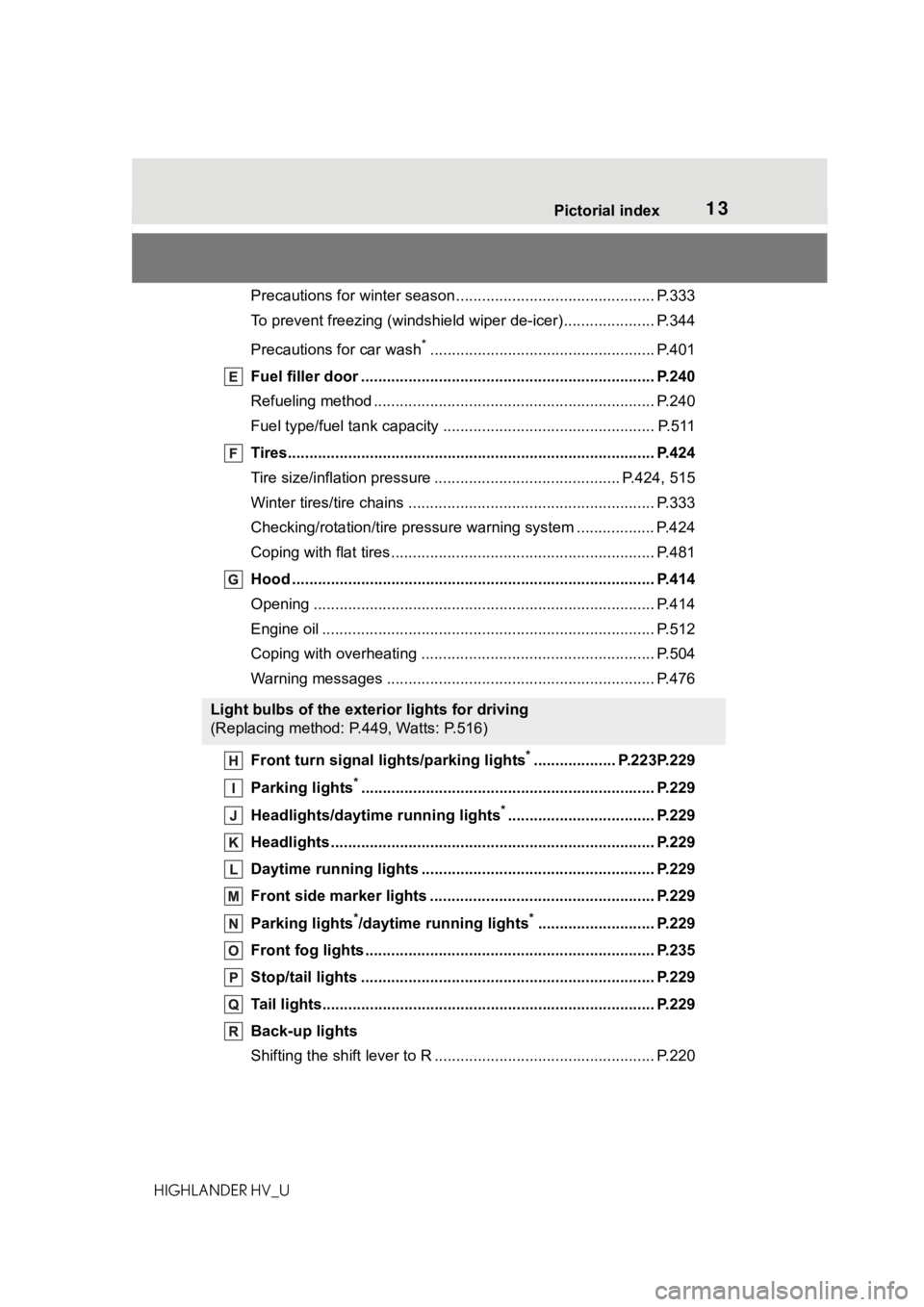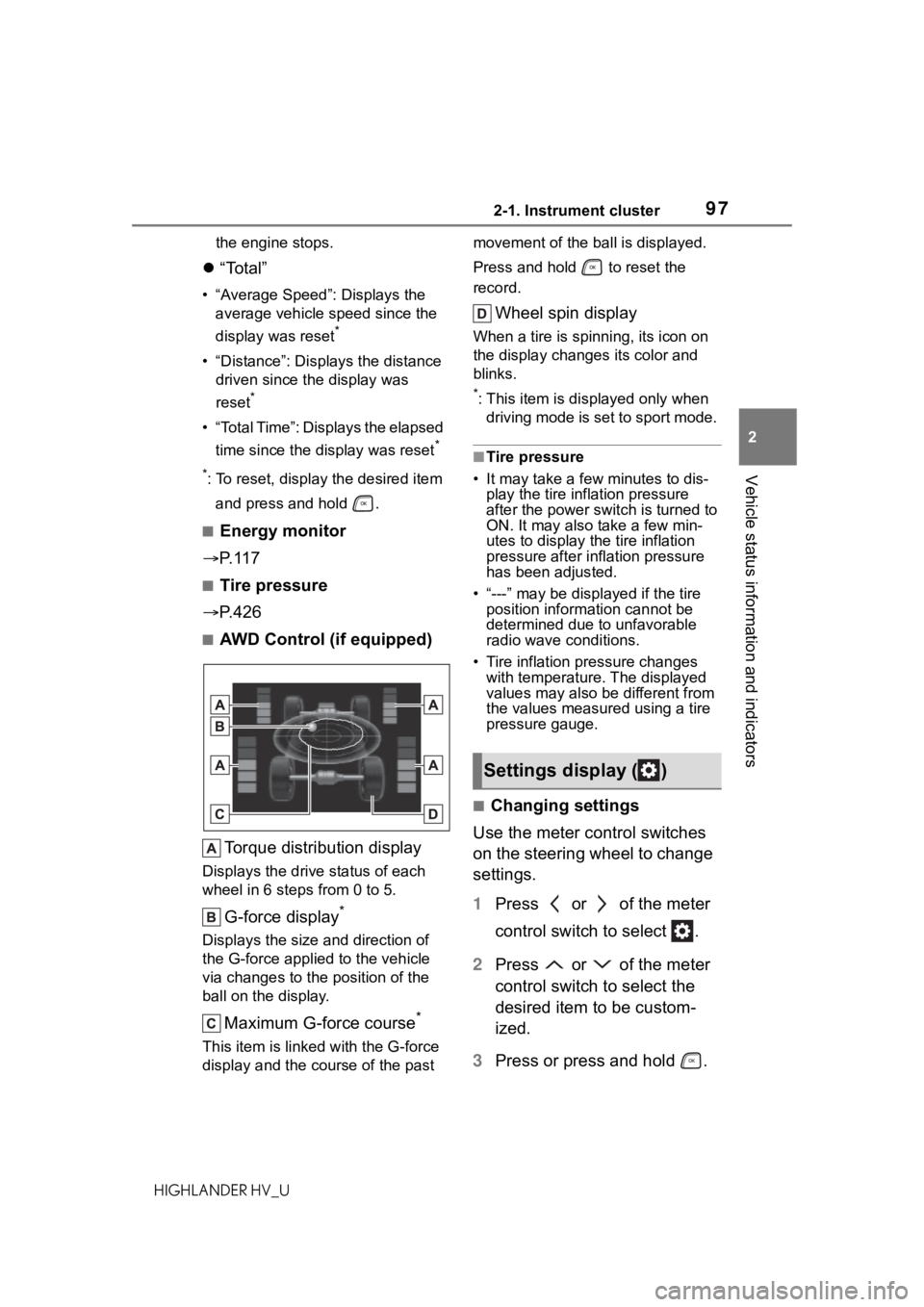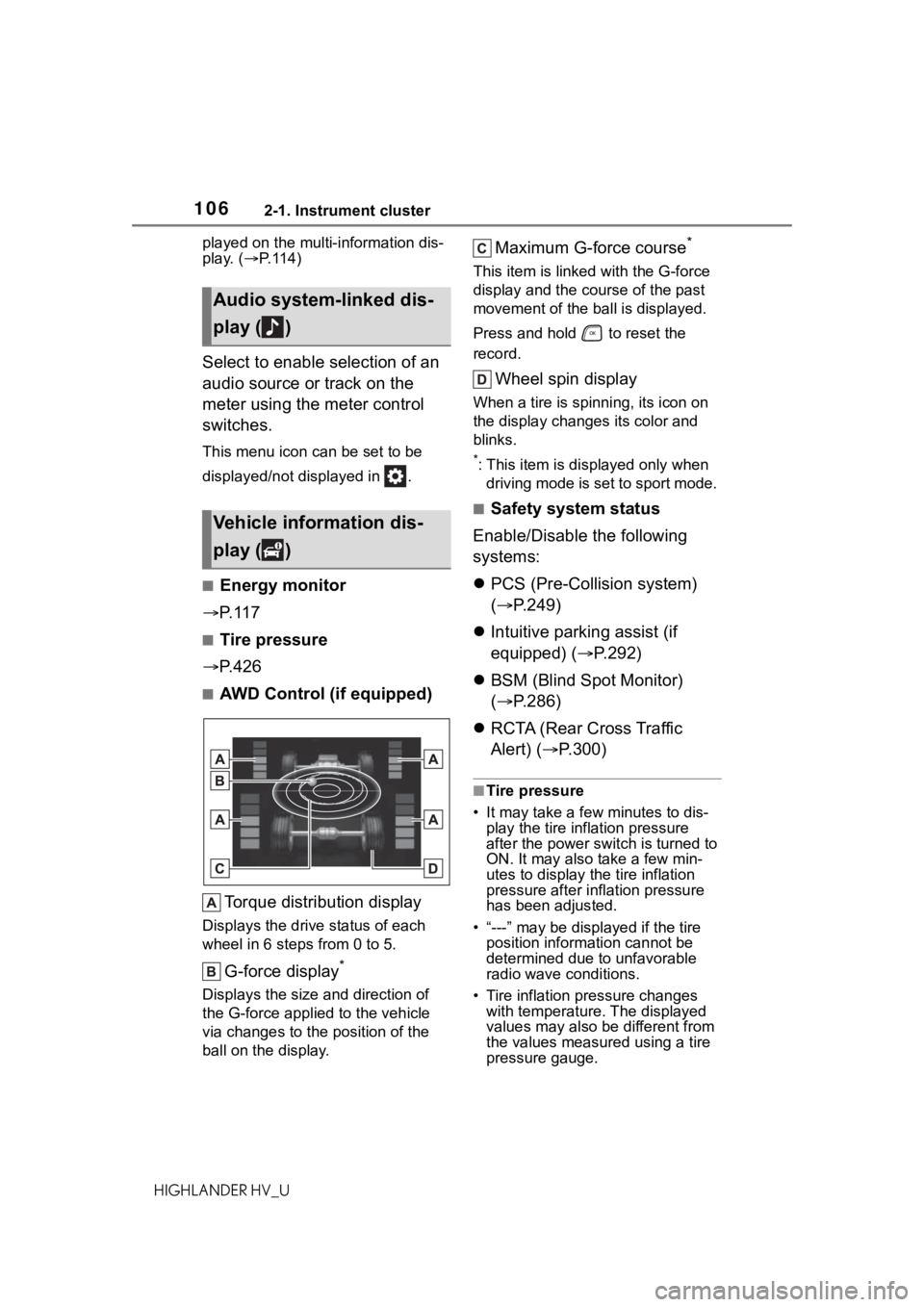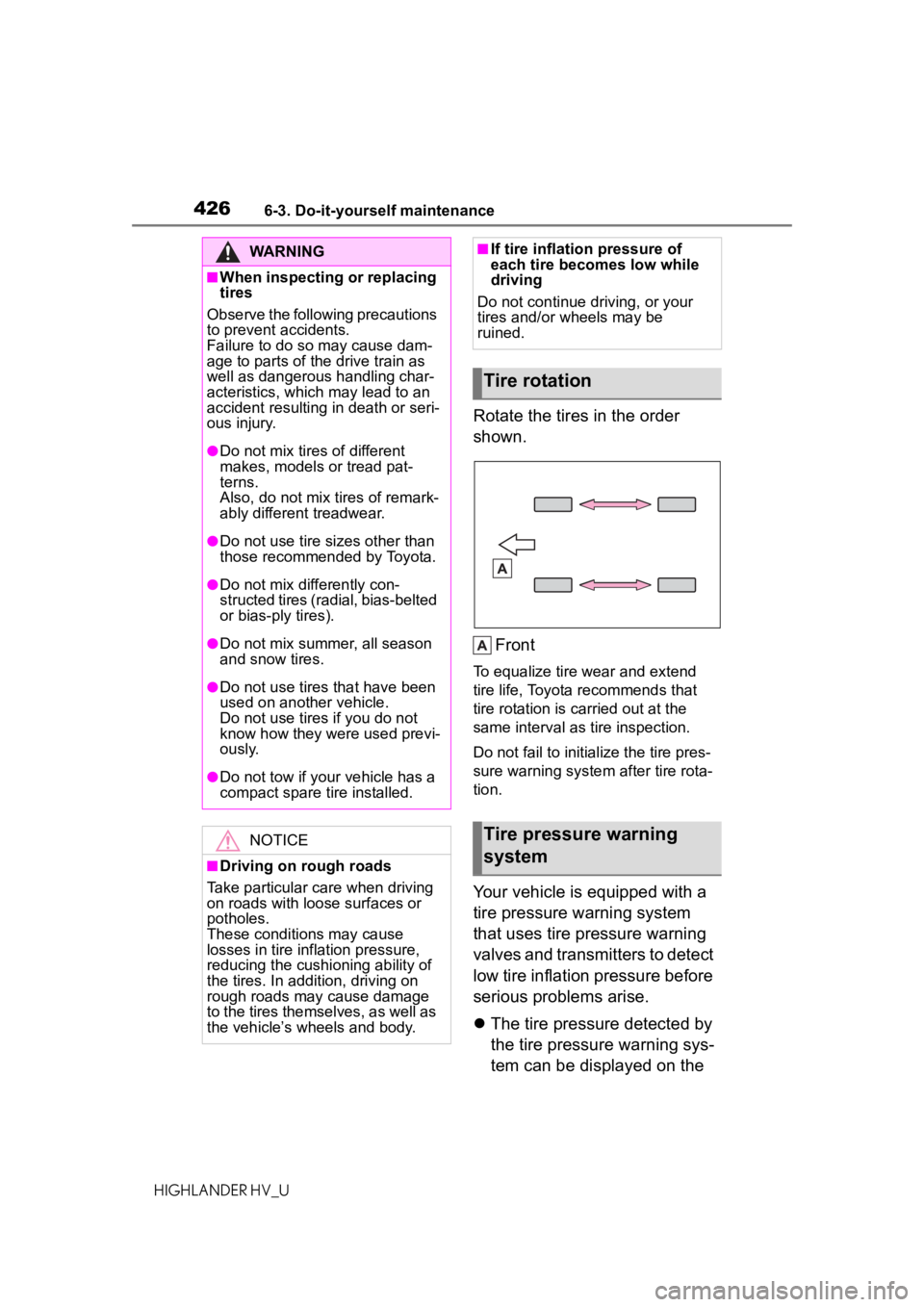inflation pressure TOYOTA HIGHLANDER HYBRID 2021 Owners Manual (in English)
[x] Cancel search | Manufacturer: TOYOTA, Model Year: 2021, Model line: HIGHLANDER HYBRID, Model: TOYOTA HIGHLANDER HYBRID 2021Pages: 576, PDF Size: 30.36 MB
Page 1 of 576

1
2
3
4
5
6
7
8
9
9
HIGHLANDER HV_U
Pictorial indexSearch by illustration
For safety
and securityMake sure to read through them
(Main topics: Child seat, theft deterrent system)
Vehicle status
information and
indicatorsReading driving-related information
(Main topics: Meters, multi-information display)
Before driving
Opening and closing the doors and windows,
adjustment before driving
(Main topics: Keys, doors, seats)
Driving
Operations and advice which are necessary for
driving
(Main topics: Starting hybrid system, refueling)
Interior featuresUsage of the interior features
(Main topics: Air conditioner, storage features)
Maintenance
and careCaring for your vehicle and maintenance
procedures
(Main topics: Interior and exterior, light bulbs)
When trouble
arisesWhat to do in case of malfunction and emergency
(Main topics: 12-volt battery discharge, flat tire)
Vehicle
specificationsVehicle specifications, customizable features
(Main topics: Fuel, oil, tire inflation pressure)
For ownersReporting safety defects for U.S. owners, and seat
belt, SRS airbag and headlight aim instructions for
Canadian owners
IndexSearch by symptom
Search alphabetically
Page 4 of 576

4TABLE OF CONTENTS
HIGHLANDER HV_U
Hood ..................................414
Positioning a floor jack ....... 415
Engine compartment .......... 416
12-volt battery .................... 421
Tires ................................... 424
Tire inflation pressure......... 436
Wheels ............................... 438
Air conditioning filter ........... 439
Cleaning the hybrid battery (trac- tion battery) air intake vents
and filter ........................... 441
Electronic key battery ......... 444
Checking and replacing fuses ......................................... 446
Headlight aim ..................... 448
Light bulbs .......................... 449
7-1. Essential information Emergency flashers ........... 458
If your vehicle has to be stopped in an emergency .............. 458
If the vehicle is trapped in rising water ................................ 459
7-2. Steps to take in an emergency If your vehicle needs to be towed......................................... 461
If you think something is wrong ......................................... 464
If a warning light turns on or a warning buzzer sounds .... 466
If a warning message is dis- played .............................. 476
If you have a flat tire ........... 481
If the hybrid system will not start ......................................... 493
If you lose your keys .......... 495
If the fuel filler door cannot be opened ............................. 495
If the electronic key does not operate properly ............... 496If the 12-volt battery is dis-
charged ............................ 498
If your vehicle overheats .... 504
If the vehicle becomes stuck ......................................... 507
8-1. Specifications Maintenance data (fuel, oil level, etc.) .................................. 510
Fuel information ................. 518
Tire information .................. 520
8-2. Customization Customizable features ....... 530
8-3. Initialization Items to initialize ................ 542
9-1. For owners Reporting safety defects for U.S. owners ............................. 544
Seat belt instructions for Cana- dian owners (in French) ... 544
SRS airbag instructions for Canadian owners (in French)......................................... 546
Headlight aim instructions for Canadian owners (in French)......................................... 553
What to do if... (Troubleshooting) ......................................... 55
6
Alphab etical Index
..............559
7When trouble arises
8Vehicle specifications
9For owners
Index
Page 13 of 576

13Pictorial index
HIGHLANDER HV_UPrecautions for winter seas
on.............................................. P.333
To prevent freezing (windshiel d wiper de-icer) ..................... P.344
Precautions for car wash
*.................................................... P.401
Fuel filler door ............................................... ..................... P.240
Refueling method ............................................... .................. P.240
Fuel type/fuel tan k capacity ................................... .............. P.511
Tires.......................................................... ........................... P.424
Tire size/inflation pressure ................................... ........ P.424, 515
Winter tires/tire chains ....................................... .................. P.333
Checking/rotation/tire pressur e warning system ..................P.424
Coping with flat tires......................................... .................... P.481
Hood ........................................................... ......................... P.414
Opening ............................................................................... P.414
Engine oil ..................................................... ........................ P.512
Coping with overheating ...................................................... P.504
Warning messages ............................................... ............... P.476
Front turn signal lights/parking lights
*................... P.223P.229
Parking lights
*............................................................... ..... P.229
Headlights/daytime running lights
*.................................. P.229
Headlights..................................................... ...................... P.229
Daytime running lights .. .................................................... P.229
Front side marker lights ....................................... ............. P.229
Parking lights
*/daytime running lights*........................... P.229
Front fog lights ............................................... .................... P.235
Stop/tail lights ............................................... ..................... P.229
Tail lights.................................................... ......................... P.229
Back-up lights
Shifting the shift lever to R ................................................... P.220
Light bulbs of the exterior lights for driving
(Replacing method: P.449, Watts: P.516)
Page 97 of 576

972-1. Instrument cluster
2
Vehicle status information and indicators
HIGHLANDER HV_Uthe engine stops.
“Total”
• “Average Speed”: Displays the
average vehicle speed since the
display was reset
*
• “Distance”: Displ ays the distance
driven since the display was
reset
*
• “Total Time”: Displays the elapsed
time since the display was reset
*
*
: To reset, display the desired item
and press and hold .
■Energy monitor
P. 1 1 7
■Tire pressure
P. 4 2 6
■AWD Control (if equipped)
Torque distribution display
Displays the drive status of each
wheel in 6 steps from 0 to 5.
G-force display*
Displays the size and direction of
the G-force applie d to the vehicle
via changes to the position of the
ball on the display.
Maximum G-force course*
This item is linke d with the G-force
display and the course of the past movement of the ball is displayed.
Press and hold to reset the
record.
Wheel spin display
When a tire is spi
nning, its icon on
the display changes its color and
blinks.
*: This item is displayed only when driving mode is set to sport mode.
■Tire pressure
• It may take a few minutes to dis-
play the tire inflation pressure
after the power switch is turned to
ON. It may also take a few min-
utes to display the tire inflation
pressure after infl ation pressure
has been adjusted.
• “---” may be displayed if the tire position information cannot be
determined due to unfavorable
radio wave conditions.
• Tire inflation pressure changes with temperature. The displayed
values may also be different from
the values measured using a tire
pressure gauge.
■Changing settings
Use the meter control switches
on the steering wheel to change
settings.
1 Press or of the meter
control switch to select .
2 Press or of the meter
control switch to select the
desired item to be custom-
ized.
3 Press or press and hold .
Settings display ( )
Page 106 of 576

1062-1. Instrument cluster
HIGHLANDER HV_Uplayed on the multi-information dis-
play. (
P.114)
Select to enable selection of an
audio source or track on the
meter using the meter control
switches.
This menu icon can be set to be
displayed/not displayed in .
■Energy monitor
P. 1 1 7
■Tire pressure
P. 4 2 6
■AWD Control (if equipped)
Torque distribution display
Displays the drive status of each
wheel in 6 steps from 0 to 5.
G-force display*
Displays the size and direction of
the G-force applie d to the vehicle
via changes to the position of the
ball on the display.
Maximum G-force course*
This item is linke d with the G-force
display and the co urse of the past
movement of the ball is displayed.
Press and hold to reset the
record.
Wheel spin display
When a tire is spi nning, its icon on
the display changes its color and
blinks.
*: This item is displayed only when driving mode is set to sport mode.
■Safety system status
Enable/Disable the following
systems:
PCS (Pre-Colli sion system)
( P.249)
Intuitive parking assist (if
equipped) ( P.292)
BSM (Blind Spot Monitor)
( P.286)
RCTA (Rear Cross Traffic
Alert) ( P.300)
■Tire pressure
• It may take a few minutes to dis-
play the tire inflation pressure
after the power switch is turned to
ON. It may also take a few min-
utes to display the tire inflation
pressure after infl ation pressure
has been adjusted.
• “---” may be displayed if the tire position information cannot be
determined due to unfavorable
radio wave conditions.
• Tire inflation pressure changes with temperature. The displayed
values may also be different from
the values measured using a tire
pressure gauge.
Audio system-linked dis-
play ( )
Vehicle information dis-
play ( )
Page 259 of 576

2594-5. Using the driving support systems
4
Driving
HIGHLANDER HV_Ustarted the vehicle has not been
driven for a certain amount of time
• While making a left/right turn and
for a few seconds after making a
left/right turn
• While driving on a curve and for a
few seconds after driving on a
curve
• If your vehicle is skidding
• If the front of the vehicle is raised
or lowered
• If the wheels are misaligned
• If a wiper blade is blocking the front camera
• The vehicle is being driven at extremely high speeds
• When driving on a hill
• If the radar sensor or front camera
is misaligned
• When driving in a traffic lane sep-
arated by more t han one lane
where oncoming vehicles are driv-
ing while making a right/left turn
• When largely out of place with the opposite facing targeted oncom-
ing vehicle during a right/left turn
• While making a right/left turn, when a pedestrian approaches
from behind or side of your vehicle
●In addition to the above, in some
situations, such as the following,
the emergency steering assist
may not operate.
• When the white (yellow) lane lines are difficult to see, such as when
they are faint, diverging/merging,
or a shadow is cast upon them
• When the lane is wider or nar-
rower than normal
• When there is a light and dark pat- tern on the road surface, such as
due to road repairs
• When the target is too close
• When there is insufficient safe or unobstructed space for the vehicle
to be steered into
• If oncoming vehicle is present
• If VSC function is operating
●In some situations such as the fol-
lowing, sufficien t braking force or
steering force may not be
obtained, preventing the system
from performing properly:
• If the braking functions cannot operate to their full extent, such as
when the brake parts are
extremely cold, ext remely hot, or
wet
• If the vehicle is not properly main- tained (brakes or tires are exces-
sively worn, imprope r tire inflation
pressure, etc.)
• When the vehicle is being driven on a gravel road or other slippery
surface
• When the road surface has deep wheel tracks
• When driving on a hill road
• When driving on a road that has inclines to the left or right
■If VSC is disabled
●If VSC is disabled ( P.327), the
Page 332 of 576

3324-6. Driving tips
HIGHLANDER HV_U
gently release the brake pedal
to allow the vehicle to move for-
ward slightly while avoiding
overuse of the accelerator
pedal. Doing so can help control
excessive gasoline consump-
tion.
Control and maintain the vehicle
at a constant speed. Before
stopping at a toll booth or simi-
lar, allow plenty of time to
release the accelerator and gen-
tly apply the brakes. A greater
amount of electrical energy can
be regenerated when slowing
down.
Use the air conditioning only
when necessary. Doing so can
help reduce excessive gasoline
consumption.
In summer: When the ambient
temperature is high, use the
recirculated air mode. Doing so
will help to reduce the burden on
the air conditioning system and
reduce fuel consumption as
well.
In winter: Because the gasoline
engine will not automatically cut
out until it and the interior of the
vehicle are warm, it will con-
sume fuel. Also, fuel consump-
tion can be improved by
avoiding overuse of the heater.Make sure to check the tire infla-
tion pressure frequently.
Improper tire inflation pressure
can cause poor fuel economy.
Also, as snow tires can cause
large amounts of friction, their
use on dry roads can lead to
poor fuel economy. Use tires
that are appropriate for the sea-
son.
Carrying heavy luggage will lead
to poor fuel economy. Avoid car-
rying unnecessary luggage.
Installing a large roof rack will
also cause poor fuel economy.
Since the gasoline engine starts
up and cuts out automatically
when cold, warming up the
engine is unnecessary. More-
over, frequently driving short
distances will cause the engine
to repeatedly warm up, which
can lead to excess fuel con-
sumption.
Highway driving
Air conditioning
Checking tire inflation
pressure
Luggage
Warming up before driv-
ing
Page 399 of 576

399
6
6
Maintenance and care
HIGHLANDER HV_U
Maintenance and care
.6-1. Maintenance and careCleaning and protecting the vehicle exterior .......... 400
Cleaning and protecting the vehicle interior ........... 403
6-2. Maintenance Maintenance requirements.................................. 406
General maintenance.. 408
Emission inspection and maintenance (I/M) pro-
grams ........................ 410
6-3. Do-it-yourself mainte- nance
Do-it-yourself service pre- cautions ..................... 412
Hood ........................... 414
Positioning a floor jack .................................. 415
Engine compartment ... 416
12-volt battery ............. 421
Tires ............................ 424
Tire inflation pressure.. 436
Wheels ......... ...............438
Air conditioning filter .... 439
Cleaning the hybrid battery (traction battery) air intake
vents and filter ........... 441
Electronic key battery.. 444
Checking and replacing fuses.......................... 446
Headlight aim .............. 448Light bulbs ...................
449
Page 413 of 576

4136-3. Do-it-yourself maintenance
6
Maintenance and care
HIGHLANDER HV_U
Hybrid battery
(traction bat-
tery) air intake
vent (P.441)• Vacuum cleaner,
etc.
• Phillips screw- driver
Headlight aim
( P.448)• Phillips-head
screwdriver
Light bulbs
( P.449)
• Bulb with same
number and
wattage rating as
original
• Phillips-head screwdriver
• Flathead screw- driver
• Wrench
Radiator and
condenser
( P.419)
Tire inflation
pressure
( P.436)• Tire pressure
gauge
• Compressed air source
Washer fluid
( P.420)
• Water or washer
fluid containing
antifreeze (for
winter use)
• Funnel (used only for adding
water or washer
fluid)
WARNING
The engine compartment contains
many mechanisms and fluids that
may move suddenly, become hot,
or become electrically energized.
To avoid death or serious injury,
observe the following precautions.
ItemsParts and tools■When working on the engine
compartment
●Make sure that the “ACCES-
SORY” or “IGNITION ON” on
the multi-information display
and the “READY” indicator are
both off.
●Be careful not to touch the
engine, power control unit, radi-
ator, exhaust manifold, etc. right
after driving as they may be hot.
Oil and other fluids may also be
hot.
●Do not leave anything that may
burn easily, such as paper and
rags, in the engine compart-
ment.
●Do not smoke, cause sparks or
expose an open flame to fuel.
Fuel fumes are flammable.
■When working near the elec-
tric cooling fan or radiator
grille
Be sure the power switch is off.
With the power switch in ON, the
electric cooling fa n may automati-
cally start to run if the air condi-
tioning is on and/or the coolant
temperature is high. ( P.419)
■Safety glasses
Wear safety glasses to prevent
flying or falling material, fluid
spray, etc. from getting in your
eyes.
NOTICE
■If you remove the air cleaner
filter
Driving with the air cleaner filter
removed may cause excessive
engine wear due to dirt in the air.
Page 426 of 576

4266-3. Do-it-yourself maintenance
HIGHLANDER HV_U
Rotate the tires in the order
shown.
Front
To equalize tire w ear and extend
tire life, Toyota recommends that
tire rotation is carried out at the
same interval as tire inspection.
Do not fail to initialize the tire pres-
sure warning system after tire rota-
tion.
Your vehicle is equipped with a
tire pressure warning system
that uses tire pressure warning
valves and transmitters to detect
low tire inflation pressure before
serious problems arise.
The tire pressure detected by
the tire pressure warning sys-
tem can be displayed on the
WARNING
■When inspecting or replacing
tires
Observe the following precautions
to prevent accidents.
Failure to do so may cause dam-
age to parts of t he drive train as
well as dangerous handling char-
acteristics, which may lead to an
accident resulting in death or seri-
ous injury.
●Do not mix tires of different
makes, models or tread pat-
terns.
Also, do not mix tires of remark-
ably different treadwear.
●Do not use tire sizes other than
those recommended by Toyota.
●Do not mix differently con-
structed tires (radial, bias-belted
or bias-ply tires).
●Do not mix summer, all season
and snow tires.
●Do not use tires that have been
used on another vehicle.
Do not use tires if you do not
know how they were used previ-
ously.
●Do not tow if your vehicle has a
compact spare tire installed.
NOTICE
■Driving on rough roads
Take particular care when driving
on roads with loose surfaces or
potholes.
These conditions may cause
losses in tire inf lation pressure,
reducing the cushio ning ability of
the tires. In addit ion, driving on
rough roads may cause damage
to the tires themselves, as well as
the vehicle’s wheels and body.
■If tire inflation pressure of
each tire becomes low while
driving
Do not continue driving, or your
tires and/or wheels may be
ruined.
Tire rotation
Tire pressure warning
system